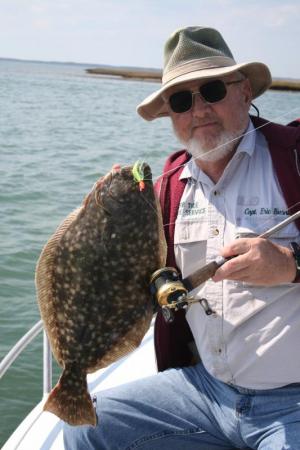We have been talking about flounder fishing, and there are flounder at Indian River Inlet, but they are hard to come by. Since these fish live on the bottom, and the bottom of the inlet is littered with rocks and other tackle-eating objects, removing said flounder is a difficult and expensive process.
I will tell you – the best way to learn how to catch flounder out of Indian River Inlet is to go out with Capt. Aaron Hurd on the Gale Force. He runs half-day trips and has considerable experience fishing the inlet not only for flounder, but also for blues and striped bass. His phone number is 302-245-2836.
If you want to go it alone, bring plenty of tackle and be aware that Indian River Inlet is a very dangerous place. The current is swift and the rocks are hard. Last summer, I watched a man fishing alone let his boat drift into the rocks. He was lucky; his boat bounced off, and that got his attention in time to move away before the boat was further damaged.
There are also sand bars that can put you aground. I have bounced off these more than once. They have a tendency to change with storms, and also from dredging by the state and federal governments.
I never fish east of the inlet bridge. I generally drift along the shallow area from the campground on the south side to Southside Marina. You must be aware of shore fishermen who also fish this area and give them plenty of room.
On the north side, I will drift from the Green Can back toward Southshore Marina, if the sandbar is making a rip along that line. If not, I will work the pocket at Bubblegum Beach just west of the Coast Guard Station. Here too, you must respect the fishermen working from shore.
I see many people trying to fish the inlet with the same rigs they would use on a smooth, sandy bottom. Tackle shops love these people.
I use a bucktail with either a live minnow or Gulp! crawfish in orange as a trailer. The weight of the bucktail must be enough to keep my line as close to 90 degrees to the water as possible. I hold the rod and reel in my hand and use braided line with a mono leader. This allows me to feel the bottom and hopefully keep my rig out of the rocks. This also allows me to feel the flounder when he hits my bait. No need for a drop back when fishing with a bucktail. Set the hook right away.
When you get snagged on the bottom, clamp down on the drag and break off the rig. Do not try to go back and free it. You will only cause a problem with everyone else drifting the same area, and the chances of actually getting the rig back are at best 50/50. I told you fishing here was expensive.
I keep a few bucktails rigged and ready to go. When I lose one, I can attach another very quickly and be back fishing in no time. Most of the time the mono leader will break at the snap that I use to attach the bucktail. Sometimes the leader will part from the braided line at the Albright knot. When that happens, it does take a bit longer to retie. If you tie your bucktail directly to the mono leader you simply retie with an improved clinch knot. Most of the time I will use a 20- or 30-pound leader with 30-pound braid running line. I fish with conventional gear, but spinning will work just as well in this shallow water.
Some anglers, including Capt. Hurd, fish tight to the rocks. I don’t do that, because I am afraid. If you want to try, realize that you can’t do this alone. Someone has to run the boat while the crew fishes. I have watched Capt. Hurd work this area and get scared just seeing how he does it, let alone trying it myself. I guess I just don’t love flounder that much.
Finally, we have the use of live spot for flounder. No question, live spot will produce the biggest flounder around. The problem is, there just are not that many big flounder around.
I use some sort of fish-finder rig with a circle and just enough weight to encourage the spot to swim to the bottom. I place the circle hook through the eye socket, but not through the eyes of the spot. Once there, it is a waiting game.
When the flounder picks up the bait, you will have to let him move off with it before engaging the drag and letting the circle hook do its job.






















































